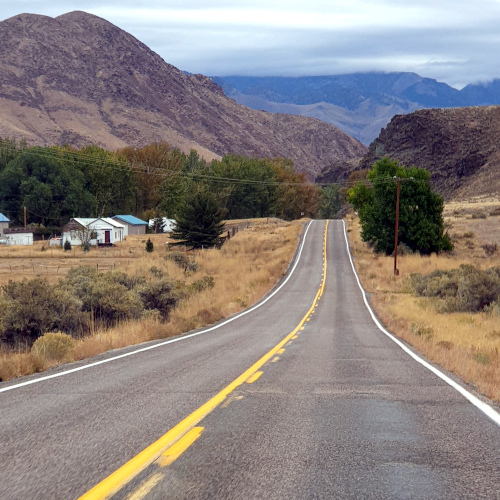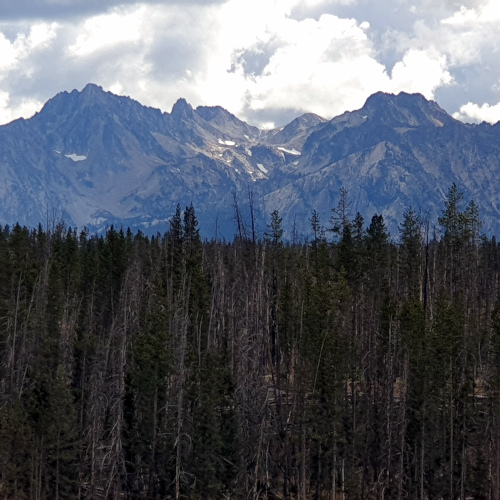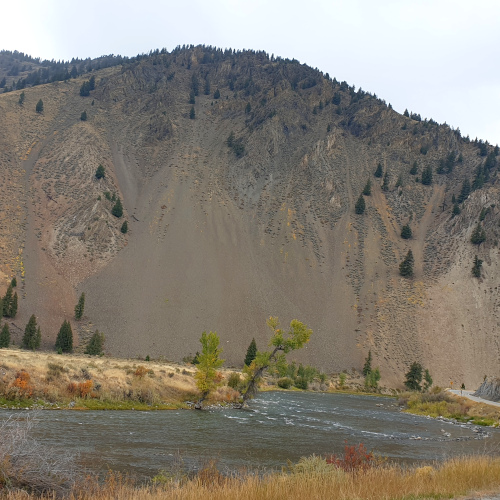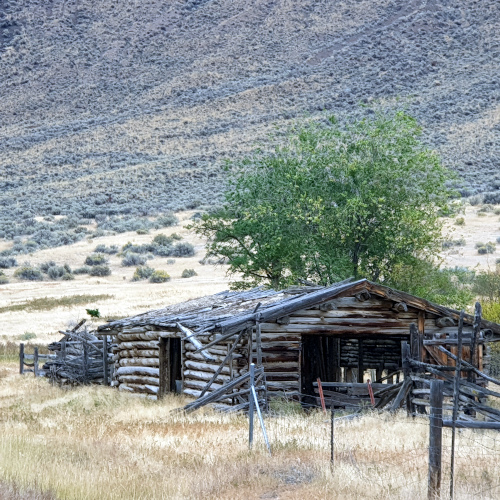From Stanley to Salmon

Idaho, October 2022: a land whose beauty and intrigue swelled as I ventured north. I remember back to my disappointment in the summer of 1998, when my Greyhound bus crossed both Montana and Idaho at night, leaving me in western Washington state at dawn. Those were the two places I was most excited to see.
And now I'm in Stanley, a mountain outpost 6253' above sealevel, nestled at the foot of the fierce-looking Sawtooths. To get here I've topped the ridge at Mount Galena (now riven in streaks of burnt trees and charcoal). The road is easy and driveable, but the snow-stakes that mark the edge are a towering 8' high, a silent reminder this is the land of winter. I drive under a grey band of strata clouds that forces the morning light in at angles, like a cat under the duvet. The mountains glow with morning and are extinguished as I move northward. This valley is glacial for sure, plunked at the bottom of the rounded bathtub basin drained by the Salmon River.

I've driven past Redfish Lake, the farthest and most challenging of the Sockeye breeding places: they used to swim 1400 miles upstream to get here, where their colored sides turned the waters red. Now the little ones don't make it through the still water pools full of predators and are trucked to the sea en masse. I've also passed the old gold rush ghost town of Vienna, now just dust.
My modern map has neglected to show me that from Stanley I'd spend the day descending in altitude. I'd have liked to know that, although recognizing I'd be trailing the Salmon River all day should have been a clue. The river is a magnesium slug under the heavy skies, burbling jubilantly at my side as we navigate thinning forests in our descent. Methane hisses from a vent on the bank, reminding how this valley began: with magma. Just shy of Clayton, rockslides stop at roadside but continue to the water's edge and remind how this valley will end: with rock. The narrow ledge of asphalt on which I proceed (effortlessly) seems an anomaly, and the rockfalls lying at the angle of repose seem only to have paused long enough to catch their breath while they wait the next tremor.
In this valley the treasure is apparently below-ground, was or is. The Clayton Smelter reminds me of our earliest desire here, but the valleys are increasingly arid and desolate, painted in colors I have to reach for: copper, rust, burnt ochre, sesame seed, sage, the green patina of wet copper. The landscape is breathtaking but I've only arrived and I already miss my Carolina loblolly pines. It seems if I were to climb the rubble of one of those loose peaks I would be rewarded with the view of other, bare peaks - worth it, for sure, but still melancholy. The maps shows I'm dancing along the fingertips of valleys lush with irrigated hay. At the gas station, Mexican farm hands shuffle with hands in the pockets of their padded flannel jackets, trying to stay low profile under their long, grey moustaches and cowboy hats.

The spare landscape spells out our most basic needs: energy to do work, water, arable land, human companionship (but not much of it). Uphill, the bighorn sheep bide their time until evening so they can descend to the river's edge and drink. Such is the misfortune of geography that humans build roads along the easy slopes of river valleys, forcing every other creature to cross a roadway to slake its thirst.
The hills grow craggy. The landscape attracts people of solitude who dislike and distrust the government beyond its provision of tax-free diesel to run the irrigation pumps. Ammon Bundy is running for office. A roadside sign berates environmentalists' role in the forest fires, not altogether unfounded. Outside of Salmon they sell ammo in bulk.
After Challis, everything is a gulch. Here is where mankind gathers, and fire. The hillsides grow rawer and take on the look of a volcanic landscape. I've had to study the shifting fire maps incessantly while planning the trip: the Moose Fire, burning since July, had once closed this road to traffic and evacuations still continue.

North of Elk Bend I cross the 45th parallel. I'm halfway between the pole and the equator. But in October the world feels more wintery than tropical, and snow isn't far away, the only way to completely extinguish what's left of the fires burning up cracks of the upper gulches.
Beside me, the Salmon River broadens, lightens under the late morning sun, going from mercury to turquoise over the rippling river bed. The valley opens up under a carpet of agriculture. I pass through the town of Salmon, a grid of red-brick buildings, a movie theater, a gas station full of fast food and cigarettes. We love the rugged landscape, but we live where life isn't quite as hard.
Trackbacks
The author does not allow comments to this entry

Comments
Display comments as Linear | Threaded